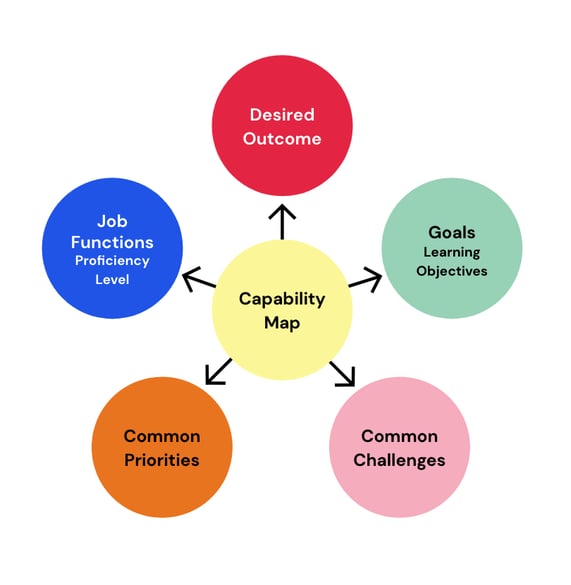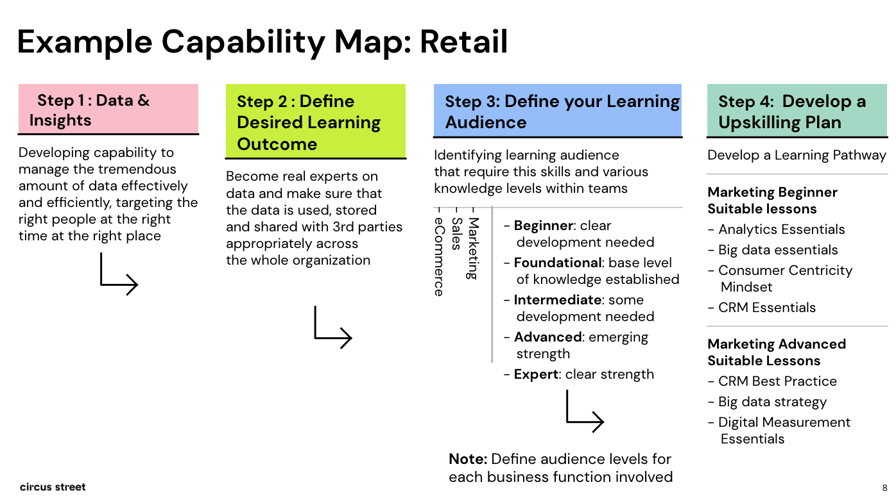How a capability gap analysis can help you build a robust L&D plan to support digital transformation, close your skills gap, and select the best skills provider.
According to 78% of over 1200 business leaders interviewed by McKinsey in 2020, capability building is important to their organisation's long-term growth. Even so, gaps are happening in real or near-real time. Over 40% of respondents in the survey said that they were experiencing capabilities gaps at the time of the survey, with about a third saying they expected to experience them within the next 2-to-5 years.

Figure 1 McKinsey Chart: % of Leaders who say capability building is important now versus before Covid-19
To address current or looming capabilities gaps, companies first need to identify the limitations of their current digital skills. Then they need to figure out how to equip staff with the skills they need to drive the kind of digital transformation that will keep them competitive in the market. A great way to address the skills gap is through a learning and development (L&D) upskilling program.
Changes in customer behavior and technology can happen quickly, which means companies need to be agile enough to react and adapt. But what are the signs of a gap?
"The sales and marketing leaders we speak to have a need for their staff to be more aware of eCommerce and the best practices required to succeed in that environment," said Kristy Houtman, Circus Street's SVP of Strategy and Growth. "Data and having more data literate employees is also a trend we are seeing across our clients and their areas of focus for capability building. It's becoming far more important in the commercial world to answer questions about data like: What are you looking at? How are you looking at it? What does it mean? Why do you need it?"
A capability gap analysis helps executive leadership identify any digital skills gap that exists across a range of digital topics, including eCommerce, data, analytics, social media, and omnichannel marketing. Tools like an internal skills audit and capability gap analysis template provide tangible ways to create a plan to address training and upskilling across your organization.
Our goal with this guide is to provide clear steps on how you can identify capability gaps in your organization by assessing your current capabilities and creating a framework for upskilling your team. We’ll also include tips on how to find and implement an upskilling solution, including what you should look for in an upskilling partner.
The following topics are included:
What is a capability gap?
A capability gap is the difference between what your company can do now and the skills and capabilities your organization needs to achieve a specific goal or initiative. Identifying a capability gap helps you understand the best place to invest your resources and focus your efforts when it comes to training, technology, and hiring.
What is a capability gap analysis?
A capability gap analysis, is the process of identifying your current capabilities and determining how well they support a specific business goal or objective. A gap analysis helps you identify where your organization falls short in terms of the skills, processes, or resources you need to achieve a goal or goals.
Why is it important?
Identifying capability gaps enables you to create a training program tailored to your organization's specific business goals. Here are a few examples of eCommerce-focused goals that a manufacturer or traditional retailer might have:
- Improve omnichannel customer experience
- Roll out new products more quickly
- Improve data intelligence
- Take advantage of social selling
- Improve or enable eCommerce functionality
- Achieve better organizational interoperability
- Enable a seamless omnichannel shopping experience
- Add new retail/fulfilment features like curbside pickup
- Better leverage content for lead generation
Achieving any of the above goals requires a range of skills and capabilities that go beyond a single lesson or certification. Improving omnichannel customer experience, for example, requires content and channel optimization, an understanding of data and how it informs customer experience, and an understanding of how to create a seamless omnichannel journey.
Beyond providing a roadmap for learning, a capability gap analysis benefits your organization in several tangible ways including:
Clearly defines what's needed by stakeholders and leadership
A capability gap analysis produces a list of needs that can be met with training, technology, or hiring. This is a tangible - and necessary - way to demonstrate the need for upskilling and help your HR department understand what employees need to achieve a given initiative.
A capability gap analysis is the best way to create an upskilling plan that focuses on the right topics, whether it’s eCommerce, data and insights, brand building in the digital age or a combination of all of these.
Gives you a comprehensive understanding of current capabilities and employee skillsets
Understanding employee strengths and knowledge gaps is part of the capability gap assessment process. It's also where you'll begin to unify different teams and departments, pulling on your senior leadership to help define your current capabilities.
You’ll need to pull on your subject matter experts (SME) within each relevant department to help you understand the core skills and competencies that are required to achieve your goal. This is the foundation of the framework you'll build when creating your learning plan and choosing a skills provider.
Aligns learning goals with customer needs
A capability gap analysis should include feedback from your customers to help identify specific capability goals. We recommend soliciting customer feedback and speaking to your customer service SMEs to help identify customer pain points.
What are customers saying they want? In the context of eCommerce, this could be the ability to place an order online and pick it up locally or have it delivered the same day. For CPG, it could mean the ability to buy directly from the manufacturer or schedule repeat deliveries for items like laundry soap that need constant replenishing. The real issues impacting customers are what informs the development of a learning plan for your employees.
Prepares your organization to be more competitive
Understanding what the market looks like is the best way to begin focusing on your training needs and objectives. As you assess existing capabilities and skill sets, you should be looking at what your competitors are doing that you're not, but also at customer preferences and changing behaviors.
Your competitors may be embracing technologies like AI and big data to create more personalized customer experiences, and expanding into new markets like D2C retail, or introducing new product lines. The new capabilities you plan to incorporate should be informed by market demand, customer feedback, and competitive behavior.
Provides a roadmap for your technology investments
Technology is what powers your digital capabilities. When assessing capability gaps, we recommend doing an audit of current platforms, processes, and information hubs/silos to determine if your existing technology infrastructure can support your business objectives.
Capability needs could be focused on eCommerce experiences, data unification, customer service, or something else entirely. Whatever your goal, having an up-to-date technology stack is essential. Going through the process of capability mapping helps identify the gaps in your digital infrastructure, which allows you to plan for the technology investments necessary to meet your upskilling objectives.
Getting started - the first 5 questions to ask
Digitization initiatives fail for many reasons including a lack of strong executive participation, inadequate technology, and siloed teams that lack the infrastructure and guidance to fully collaborate.
Identifying the skills needed for transformation is key to effectively filling a capability gap. Over half of the respondents in a recent Gartner survey said the top barrier to workforce transformation was an inability to identify needed skills, with a third reporting that they have no way to identify market-leading skills. The best way to identify what’s needed is to ask the right questions—here are 5 to get you started:
1. What do you need to know?
Start by focusing on the broadest question—what does your organization need to know to achieve a desired goal, stay competitive, or complete a digitization project? Specifically, what marketing-specific knowledge, technology, skills, abilities, and behaviors do you need to know or improve? Your answer should be tied to the goal (or goals) you want to achieve, and the competencies needed to achieve it.
For example, let's say you're a CPG brand that wants to develop skills around data-driven marketing and customer insights. Your question should be: What does my team need to know about data to better understand consumer insights and apply them to ultimately increase product sales?
The answer is focused on data. You need to develop competency around big data, analytics, and consumer centricity. Your digital skills gap analysis will, therefore, be focused on identifying gaps in data management, storytelling, visualization, and anything else relevant to building skills focused on data-driven marketing.
2. What departments are involved?
Once you've clarified the knowledge needed, you'll consult your SMEs across various departments like marketing, sales, IT, and eCommerce to define your answers. Your SMEs can help you define different skills levels or tiers to help you map where development is clearly needed to where proficiency already exists.
This is the beginning of the capability map that you’ll use to identify a digital skills gap and build a framework that defines competencies and focuses on filling it.
3. What is your learning framework?
The next step is to audit the existing capabilities in your organization so you can create a learning framework that fits your needs. Analyzing your current capabilities and mapping them to your goals is how you’ll identify which competencies are missing, where there are redundancies, and any areas for improvement.
Pull on your SMEs to document the skills and resources you already have—both technical (expertise with CRM systems) and non-technical (soft skills like problem-solving). To map the capabilities required, you'll need to rank if you're at a beginner, intermediate, or advanced level of proficiency for a given capability. We provide more information about proficiency levels, below. Documenting a team’s proficiency around a specific skill helps you understand the type of training that's needed and the skills provider that can fill the skills gap.
4. Who needs to learn?
Once you have a framework in place, the next step is to identify who needs to learn and include what skills are associated with a given competency. Again, your SMEs will provide detail and insight here, letting you know who on their team needs to learn what skills or if the entire team needs to be upskilled, so they gain expertise around a given competency.
Using data-driven marketing as an example, the teams involved will include marketing, IT, and sales. Each team plays a different role in collecting, understanding, and activating data. Your upskilling program should therefore focus on giving every team a strong foundation in things like data ethics, data storytelling, and data visualization. Understanding the existing competencies within each team—and identifying the skills gaps—enables you to create a learning program that incorporates the right knowledge lessons and training for everyone involved in the initiative.
5. What skills provider should you use?
When the above questions are answered, you'll be ready to choose a skills provider that supports your primary objective, whatever that happens to be. When evaluating programs, make sure you have a clear understanding of how it supports your framework and goals. To ensure that you’re getting the most up-to-date and industry-relevant training in digital marketing and transformation, you should also seek out providers that have professional accreditation. Approved vendors must pass an extensive and detailed evaluation that demonstrates the highest standards of experience, education, and knowledge.
The best skills providers will equip your workforce with the knowledge they need to take on whatever new digital transformation initiative you put in place. We call this "preparedness." With peak preparedness, you'll have the knowledge, the skills, and the mindset to execute a large-scale digitization initiative.
How to create a capability map
A capability map is a visual representation of your learning objectives or goals, challenges, priorities, desired outcomes, and job functions. It includes the process of skill mapping, which helps you identify existing skills so you can understand what kind of learning program to invest in. A capability map shows how each of these key areas relate to each other and clearly delineates the proficiency levels that your organization is currently at—beginner, foundational, intermediate, advanced, or expert—for a given skillset.
Here’s an example of how competency / proficiency levels could appear in a capability map:
| Beginner |
Foundational |
Intermediate |
Advanced |
Expert |
| Clear Development Needed |
Base level of subject knowledge
|
Some Development Needed |
Emerging Strength |
Clear Strength |
- Beginner: clear development needed – employee or team demonstrates gaps in knowledge—or a significant skills deficiency—across a specific capability like data management.
- Foundational: base level of knowledge established – employee or team is familiar with the concept and application of a skill, but additional training is needed to begin using this knowledge in the workplace.
- Intermediate: some development needed – employee or team may demonstrate skill in one area of a capability (e.g. big data), but knowledge is inconsistent and gaps are present.
- Advanced: emerging strength – employee or team has a strong grasp of a specific concept or capability (e.g. the importance of data in understanding the customer journey), but may need additional training to act on this information
- Expert: clear strength – employee or team consistently demonstrates skill or proficiency about a given capability and acts as a leader in this area.
The following components form the base inputs in a Capability mapping framework.

- Desired outcome – Name/describe the capability you want (e.g. Alignment of sales and marketing, eCommerce expertise, data mastery, etc.)
- Goals – The business goal or goals you want your learning program to help you achieve. For example, understanding a lesson about joint business planning essentials can help teams like sales and marketing learn how to work together.
- Learning objectives - Ties program learnings to specific outcomes. These can range from broad (e.g. everyone is aware of and connected to your business goals and strategy) to more specific (e.g. a solid mastery of data for the purpose of informing business and marketing decisions).
- Common challenges - Defines the common barriers to achieving your objective. Using data mastery as an example, challenges could include data silos, unfamiliarity with new channels, or a lack of leadership expertise around data governance and management.
- Common priorities - These are the areas you need to focus on to achieve your objective. In the data mastery example, common priorities could include understanding how to capture and analyze data for business insights and building a metrics-driven culture.
- Job functions - This section provides a detailed view of each team's core responsibilities, existing capabilities, and who they interact with in the course of their work. It should include a summary of team skills and capability gaps (e.g. poor digital literacy, lacks understanding of big data, etc.). This is what sets the stage for the learning modules needed to close these gaps.
- Proficiency level – Indicates a team or employee’s level of proficiency at the start of the training program.
There are four steps involved in creating a capability map, with skills mapping part of the process. They include:
- Step One: Define agreed business goals
- Step Two: Defining your desired outcome
- Step Three: Defining your learning experience
- Step Four: Developing a learning pathway

Step one of your capability map clarifies your agreed business goal or goals. Examples include things like driving more sales, master omnichannel retail, or improve departmental interoperability.
Step two of your capability map states your desired learning outcome and ties it to your established goals. It’s what you want your skills training program to help you achieve. It should be tied to a result you want (e.g. improve ROI from eCommerce) versus a broad learning topic like “know more about eCommerce.”
Step three clearly defines your learning audience including team functions, core responsibilities, hot topics for learning, and relevant departments.
Step four involves creating a learning pathway. It maps your skills gaps to the specified lessons needed to fill these gaps. It’s the foundation for your learning program and includes a list of desired behaviors/competencies you want your employees to gain.
If you are not sure where to get started, download a blank capability map template here.
What to look for in a training partner
Your skills gap analysis sets the stage for selecting the right training partner by identifying the skills you need to close any gaps.
When looking for a learning and development partner, consider these factors:
- Will the skills provider work with you to help map learner personas, job responsibilities, and skills needed to an appropriate lesson plan?
- Does their curriculum cover the topics identified in your capability gap analysis?
- Do they provide a digital learning platform with features like reporting, user benchmarking and training?
- How accessible are their courses? Are they available online, onsite, and on-demand?
- Do they have experience working within your industry?
- Are they willing to connect you with existing or past clients in your industry so you can assess client success/satisfaction?
- What is their customer support process?
- How do they help you assess program usage and whether your employees are accessing the digital learning tools they provide?
- How do they assess proficiency after their courses have been completed?
- What kind of certifications or accreditations do they offer?
We recommend putting someone with a leadership role in charge of your learning initiative, since successful upskilling needs a champion to motivate employees and model the value of continued learning. This leader not only helps highlight the importance of implementing an upskilling program, but they’ll also be at the forefront of selecting your skills provider.
"For our programs to be engaging, we need champions," said Kristy Houtman, Circus Street's SVP of Strategy and Growth.
"And that champion needs to be a senior stakeholder to explain what they're doing and why they're doing it. They need to make it clear that they're investing in upskilling because it's how they stay profitable, which means they save jobs. In today's environment, that's really important."
When closing capability gaps, you should always start with leadership since it’s their goals and priorities that drive the need for change. Then, you pull in the SMEs so you can begin mapping out what skills are needed. This informs your learning framework which is what you’ll ultimately provide to a company like Circus Street who can help you create a learning program.
“Look for a skills provider that can tailor a learning program to your needs,” said Houtman. “Every company has different goals and a workforce that have varying skill sets. Ensuring your chosen provider can build programs that fit your organisational goals, align to your employee ambitions, and understand the nuances between global markets is vital for success. If your employees don’t feel the training is relevant for them, be it in their stage of career or market, the learning won’t provide impact.”
This article was been written by Jacqueline Dooley in consultation with Kristy Houtman, SVP - Client Growth and Strategy, Circus Street.







